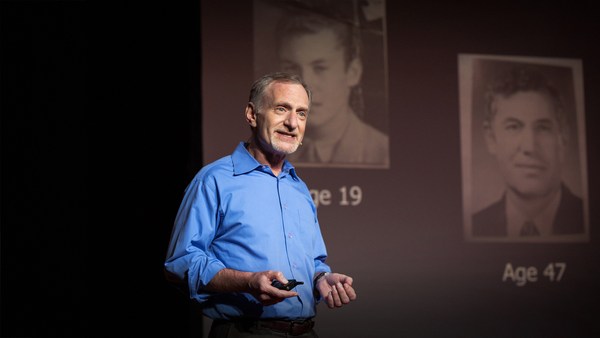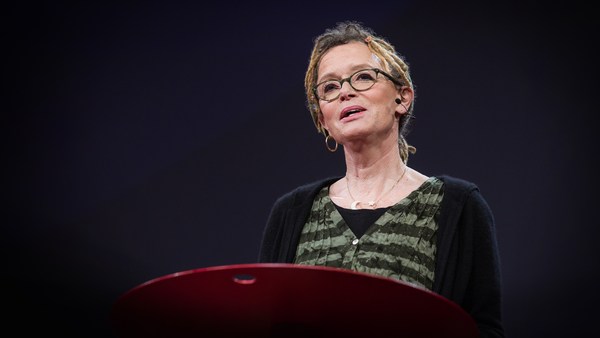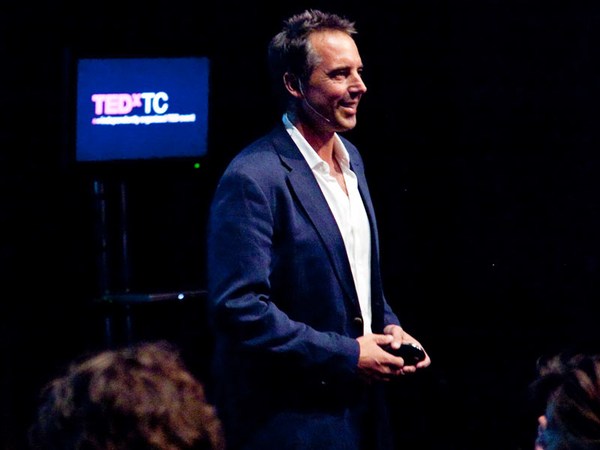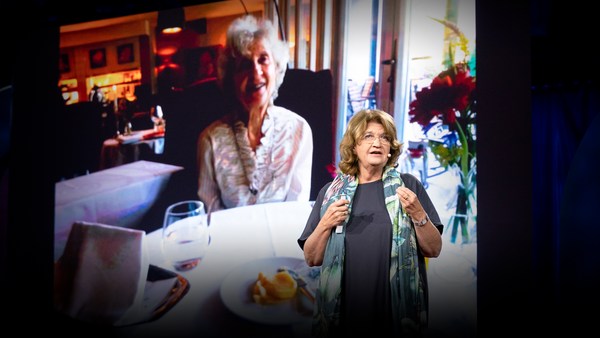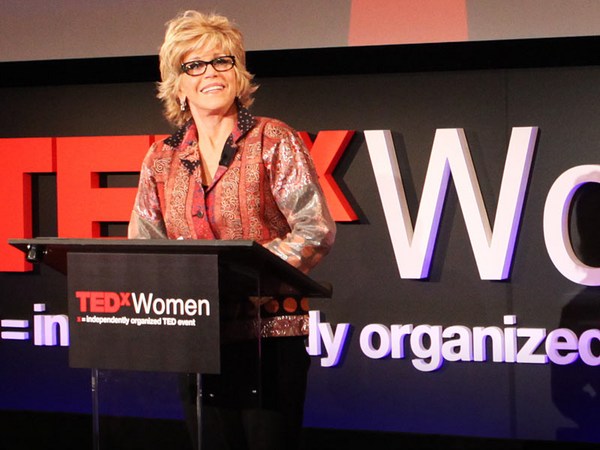Here's an intriguing fact. In the developed world, everywhere, women live an average of six to eight years longer than men do. Six to eight years longer. That's, like, a huge gap. In 2015, the "Lancet" published an article showing that men in rich countries are twice as likely to die as women are at any age.
But there is one place in the world where men live as long as women. It's a remote, mountainous zone, a blue zone, where super longevity is common to both sexes. This is the blue zone in Sardinia, an Italian island in the Mediterranean, between Corsica and Tunisia, where there are six times as many centenarians as on the Italian mainland, less than 200 miles away. There are 10 times as many centenarians as there are in North America. It's the only place where men live as long as women.
But why? My curiosity was piqued. I decided to research the science and the habits of the place, and I started with the genetic profile. I discovered soon enough that genes account for just 25 percent of their longevity. The other 75 percent is lifestyle.
So what does it take to live to 100 or beyond? What are they doing right? What you're looking at is an aerial view of Villagrande. It's a village at the epicenter of the blue zone where I went to investigate this, and as you can see, architectural beauty is not its main virtue, density is: tightly spaced houses, interwoven alleys and streets. It means that the villagers' lives constantly intersect. And as I walked through the village, I could feel hundreds of pairs of eyes watching me from behind doorways and curtains, from behind shutters. Because like all ancient villages, Villagrande couldn't have survived without this structure, without its walls, without its cathedral, without its village square, because defense and social cohesion defined its design.
Urban priorities changed as we moved towards the industrial revolution because infectious disease became the risk of the day. But what about now? Now, social isolation is the public health risk of our time. Now, a third of the population says they have two or fewer people to lean on.
But let's go to Villagrande now as a contrast to meet some centenarians.
Meet Giuseppe Murinu. He's 102, a supercentenarian and a lifelong resident of the village of Villagrande. He was a gregarious man. He loved to recount stories such as how he lived like a bird from what he could find on the forest floor during not one but two world wars, how he and his wife, who also lived past 100, raised six children in a small, homey kitchen where I interviewed him. Here he is with his sons Angelo and Domenico, both in their 70s and looking after their father, and who were quite frankly very suspicious of me and my daughter who came along with me on this research trip, because the flip side of social cohesion is a wariness of strangers and outsiders. But Giuseppe, he wasn't suspicious at all. He was a happy-go-lucky guy, very outgoing with a positive outlook. And I wondered: so is that what it takes to live to be 100 or beyond, thinking positively? Actually, no.
(Laughter)
Meet Giovanni Corrias. He's 101, the grumpiest person I have ever met.
(Laughter)
And he put a lie to the notion that you have to be positive to live a long life. And there is evidence for this. When I asked him why he lived so long, he kind of looked at me under hooded eyelids and he growled, "Nobody has to know my secrets."
(Laughter)
But despite being a sourpuss, the niece who lived with him and looked after him called him "Il Tesoro," "my treasure." And she respected him and loved him, and she told me, when I questioned this obvious loss of her freedom, "You just don't understand, do you? Looking after this man is a pleasure. It's a huge privilege for me. This is my heritage." And indeed, wherever I went to interview these centenarians, I found a kitchen party. Here's Giovanni with his two nieces, Maria above him and beside him his great-niece Sara, who came when I was there to bring fresh fruits and vegetables. And I quickly discovered by being there that in the blue zone, as people age, and indeed across their lifespans, they're always surrounded by extended family, by friends, by neighbors, the priest, the barkeeper, the grocer. People are always there or dropping by. They are never left to live solitary lives. This is unlike the rest of the developed world, where as George Burns quipped, "Happiness is having a large, loving, caring family in another city."
(Laughter)
Now, so far we've only met men, long-living men, but I met women too, and here you see Zia Teresa. She, at over 100, taught me how to make the local specialty, which is called culurgiones, which are these large pasta pockets like ravioli about this size, this size, and they're filled with high-fat ricotta and mint and drenched in tomato sauce. And she showed me how to make just the right crimp so they wouldn't open, and she makes them with her daughters every Sunday and distributes them by the dozens to neighbors and friends. And that's when I discovered a low-fat, gluten-free diet is not what it takes to live to 100 in the blue zone.
(Applause)
Now, these centenarians' stories along with the science that underpins them prompted me to ask myself some questions too, such as, when am I going to die and how can I put that day off? And as you will see, the answer is not what we expect. Julianne Holt-Lunstad is a researcher at Brigham Young University and she addressed this very question in a series of studies of tens of thousands of middle aged people much like this audience here. And she looked at every aspect of their lifestyle: their diet, their exercise, their marital status, how often they went to the doctor, whether they smoked or drank, etc. She recorded all of this and then she and her colleagues sat tight and waited for seven years to see who would still be breathing. And of the people left standing, what reduced their chances of dying the most? That was her question.
So let's now look at her data in summary, going from the least powerful predictor to the strongest. OK? So clean air, which is great, it doesn't predict how long you will live. Whether you have your hypertension treated is good. Still not a strong predictor. Whether you're lean or overweight, you can stop feeling guilty about this, because it's only in third place. How much exercise you get is next, still only a moderate predictor. Whether you've had a cardiac event and you're in rehab and exercising, getting higher now. Whether you've had a flu vaccine. Did anybody here know that having a flu vaccine protects you more than doing exercise? Whether you were drinking and quit, or whether you're a moderate drinker, whether you don't smoke, or if you did, whether you quit, and getting towards the top predictors are two features of your social life. First, your close relationships. These are the people that you can call on for a loan if you need money suddenly, who will call the doctor if you're not feeling well or who will take you to the hospital, or who will sit with you if you're having an existential crisis, if you're in despair. Those people, that little clutch of people are a strong predictor, if you have them, of how long you'll live. And then something that surprised me, something that's called social integration. This means how much you interact with people as you move through your day. How many people do you talk to? And these mean both your weak and your strong bonds, so not just the people you're really close to, who mean a lot to you, but, like, do you talk to the guy who every day makes you your coffee? Do you talk to the postman? Do you talk to the woman who walks by your house every day with her dog? Do you play bridge or poker, have a book club? Those interactions are one of the strongest predictors of how long you'll live.
Now, this leads me to the next question: if we now spend more time online than on any other activity, including sleeping, we're now up to 11 hours a day, one hour more than last year, by the way, does it make a difference? Why distinguish between interacting in person and interacting via social media? Is it the same thing as being there if you're in contact constantly with your kids through text, for example? Well, the short answer to the question is no, it's not the same thing. Face-to-face contact releases a whole cascade of neurotransmitters, and like a vaccine, they protect you now in the present and well into the future. So simply making eye contact with somebody, shaking hands, giving somebody a high-five is enough to release oxytocin, which increases your level of trust and it lowers your cortisol levels. So it lowers your stress. And dopamine is generated, which gives us a little high and it kills pain. It's like a naturally produced morphine.
Now, all of this passes under our conscious radar, which is why we conflate online activity with the real thing. But we do have evidence now, fresh evidence, that there is a difference. So let's look at some of the neuroscience. Elizabeth Redcay, a neuroscientist at the University of Maryland, tried to map the difference between what goes on in our brains when we interact in person versus when we're watching something that's static. And what she did was she compared the brain function of two groups of people, those interacting live with her or with one of her research associates in a dynamic conversation, and she compared that to the brain activity of people who were watching her talk about the same subject but in a canned video, like on YouTube. And by the way, if you want to know how she fit two people in an MRI scanner at the same time, talk to me later.
So what's the difference? This is your brain on real social interaction. What you're seeing is the difference in brain activity between interacting in person and taking in static content. In orange, you see the brain areas that are associated with attention, social intelligence -- that means anticipating what somebody else is thinking and feeling and planning -- and emotional reward. And these areas become much more engaged when we're interacting with a live partner.
Now, these richer brain signatures might be why recruiters from Fortune 500 companies evaluating candidates thought that the candidates were smarter when they heard their voices compared to when they just read their pitches in a text, for example, or an email or a letter. Now, our voices and body language convey a rich signal. It shows that we're thinking, feeling, sentient human beings who are much more than an algorithm. Now, this research by Nicholas Epley at the University of Chicago Business School is quite amazing because it tells us a simple thing. If somebody hears your voice, they think you're smarter. I mean, that's quite a simple thing.
Now, to return to the beginning, why do women live longer than men? And one major reason is that women are more likely to prioritize and groom their face-to-face relationships over their lifespans. Fresh evidence shows that these in-person friendships create a biological force field against disease and decline. And it's not just true of humans but their primate relations, our primate relations as well. Anthropologist Joan Silk's work shows that female baboons who have a core of female friends show lower levels of stress via their cortisol levels, they live longer and they have more surviving offspring. At least three stable relationships. That was the magic number. Think about it. I hope you guys have three.
The power of such face-to-face contact is really why there are the lowest rates of dementia among people who are socially engaged. It's why women who have breast cancer are four times more likely to survive their disease than loners are. Why men who've had a stroke who meet regularly to play poker or to have coffee or to play old-timer's hockey -- I'm Canadian, after all --
(Laughter)
are better protected by that social contact than they are by medication. Why men who've had a stroke who meet regularly -- this is something very powerful they can do. This face-to-face contact provides stunning benefits, yet now almost a quarter of the population says they have no one to talk to.
We can do something about this. Like Sardinian villagers, it's a biological imperative to know we belong, and not just the women among us. Building in-person interaction into our cities, into our workplaces, into our agendas bolsters the immune system, sends feel-good hormones surging through the bloodstream and brain and helps us live longer. I call this building your village, and building it and sustaining it is a matter of life and death. Thank you.
(Applause)
Helen Walters: Susan, come back. I have a question for you. I'm wondering if there's a middle path. So you talk about the neurotransmitters connecting when in face-to-face, but what about digital technology? We've seen enormous improvements in digital technology like FaceTime, things like that. Does that work too? I mean, I see my nephew. He plays Minecraft and he's yelling at his friends. It seems like he's connecting pretty well. Is that useful? Is that helpful?
Susan Pinker: Some of the data are just emerging. The data are so fresh that the digital revolution happened and the health data trailed behind. So we're just learning, but I would say there are some improvements that we could make in the technology. For example, the camera on your laptop is at the top of the screen, so for example, when you're looking into the screen, you're not actually making eye contact. So something as simple as even just looking into the camera can increase those neurotransmitters, or maybe changing the position of the camera. So it's not identical, but I think we are getting closer with the technology.
HW: Great. Thank you so much.
SP: Thank you.
(Applause)
